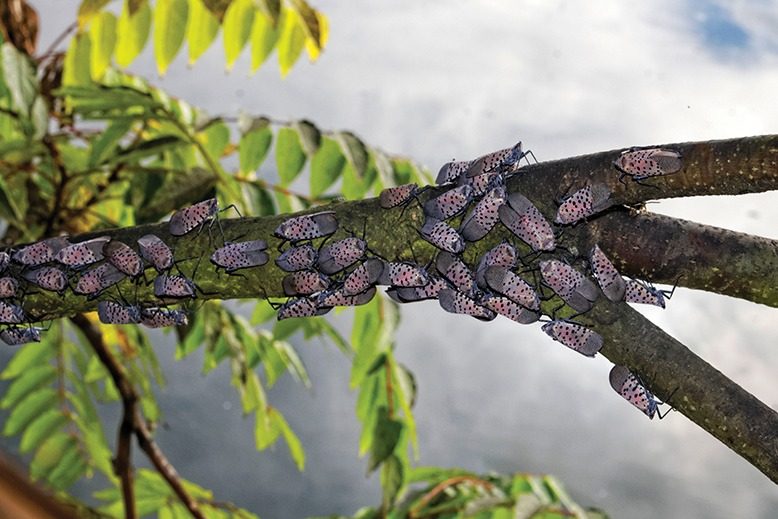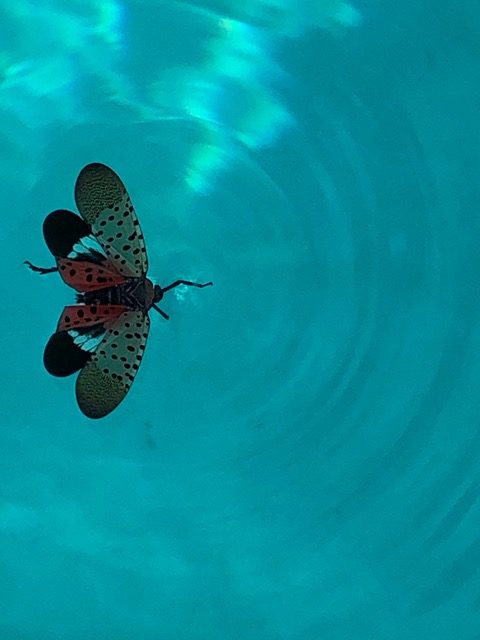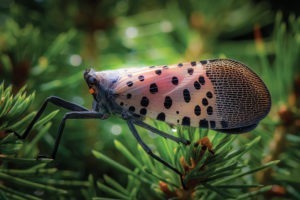
In August, Danette Daniell rescued an unfamiliar red-and-black winged insect struggling to float in her Mendham swimming pool. “I thought it was a moth,” she tells New Jersey Monthly.
The curious creature was no moth, the Morris County resident discovered the following day from a post on the neighborhood app Nextdoor, featuring the same type of bug. It was, in fact, the dreaded spotted lanternfly, an invasive pest that New Jerseyans are being instructed to kill on sight as it threatens the Garden State’s farm crops, including apples, grapes, blueberries, peaches and hops, and hardwood trees, such as oak, walnut and poplar.

Mendham resident Danette Daniell initially thought this lanternfly in her swimming pool was a moth. Photo courtesy of Danette Daniell
Three days later, Daniell saw four more of the flashy four-winged insects. On the fourth day, there were too many to count. Within a week, the 40-foot tulip poplar in her front yard was infested. “There were truly thousands of them,” she recalls in horror.
Worse, they were fanning out throughout her 5-acre property, settling onto a couple of trees of heaven (Ailanthus altissima), an invasive tree from Asia favored by the lanternfly, which also originally hails from Asia. “It was amazing to me just how fast they multiplied in our yard,” says Daniell.
First detected in North America in 2014, when they were seen in Pennsylvania, spotted lanternflies were confirmed to be in New Jersey in 2018. Today, infestations and individual sightings have been reported in nearly every county in the state, and a quarantine has been issued for 13 counties: Burlington, Camden, Gloucester, Hunterdon, Mercer, Salem, Somerset, Warren, Morris, Monmouth, Middlesex, Essex and Union. In an effort to prevent the spread, the quarantine effectively means people living and working in those counties should inspect and take care to rid their vehicles and property of the lanternfly and its eggs to prevent transporting it.
Not only are the pests expanding their territories, but their numbers are growing in counties where they’ve already established themselves. “This year, the populations have exploded in some of those areas,” says George Hamilton, chair of the department of entomology at Rutgers.
Come next summer, “if you’re in an area that currently has high numbers, they’re probably going to get larger,” Hamilton says. “If you’re in an area where they just appeared, you’ll probably see an increase. It takes a couple years to see really large numbers,” he says.
The adults don’t survive winter, but from September until the first hard freeze, the female adults lay 30 to 50 eggs in masses resembling light-gray putty. The masses can be found on tree bark, rocks, patio furniture, firewood, boats and pallets—basically, any outdoor, flat surface. Sometimes, the masses lose their mud-like covering, exposing the individual eggs that resemble seeds.

The New Jersey Department of Agriculture recommends stomping lanternflies with a shoe or crushing them with a flyswatter or spatula. Shutterstock
The New Jersey Department of Agriculture (NJDA) recommends removing the eggs by squishing them with a rock, spatula or plastic card. (You know you’re doing it right if you hear a popping sound.) After that, scrape them into a plastic bag containing rubbing alcohol or hand sanitizer, making sure the eggs come into contact with the solution before you seal and toss the bag into the trash.
The bugs have limited flying capabilities, and travel by hopping and attaching to vehicles, objects and even people. “You need to check yourself because they could be on your back, and you wouldn’t even know it,” says Hamilton.
The NJDA recommends stomping lanternflies—both nymphs, which start out in spring as black with white spots and are about an eighth of an inch in size, and adults, which grow to about an inch long, with black-spotted gray forewings and red, black and white hind wings—with a plastic card or hard object.
To date, destruction to plants and crops has, luckily, been minimal in the state, according to NJDA, which this year put out a somewhat cheeky public service announcement featuring an image of a lanternfly and the phrase, “Wanted: Dead or Alive.”
[RELATED: How Jersey Farms Cultivate Exotic Crops]
But Hamilton cautions, “If we have damage this fall, it’ll be in the vineyards. They damage the vines enough that they don’t survive the winter.”
The spotted lanternfly feeds on the sap of more than 70 plant species and excretes some of it as a sugary water. This so-called honeydew substance encourages the growth of a fungal disease on trees and plants called sooty mold, which can cause wilting, leaf curling and tree dieback. It may also lead to the plant’s premature death.
The NJDA notes that dark, sooty mold on trees are a sign that the spotted lanternfly has been present, and may have laid its eggs.
In addition to creating tree and crop damage, the pests can put a damper on outdoor activities. “We see that here at the Rutgers gardens,” says Hamilton. “I have research plots out there, and every week we go out there and they are flying around everywhere, and they land on you. People with an aversion to insects aren’t going to be too happy.”
Fighting the spread of the spotted lanternfly is a year-round effort, according to the Department of Agriculture.
Monica Cardoza hasn’t yet spotted lanternflies in her Ridgewood yard, but keeps a flyswatter at the ready.



